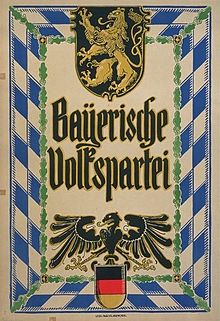Bavarian People's Party
| Bavarian People's Party | |
|---|---|
| founding | November 12, 1918 |
| resolution | 4th July 1933 |
| Headquarters | Munich |
| Alignment | Political Catholicism |
The Bavarian People's Party ( BVP ) was a German political party during the Weimar Republic .
After the Bavarian organization of the center had already played a special role during the German Empire , leading members of the Bavarian center around Georg Heim founded the BVP in Regensburg in November 1918 as the Bavarian arm of political Catholicism . The decisive factor was, on the one hand, the emphasis on federalism in contrast to the center, which was clearly more unitarian under Erzberger's influence , and, on the other hand, the much more conservative attitude (also in the assessment of the November Revolution ). The BVP mainly represented the interests of the property classes and parts of industry .
The BVP was the most elected party in all five Bavarian state elections ( early 1919 , June 1920 , April / May 1924 , May 1928 and April 1932 ) and was represented in all state governments . With Hugo Graf von und zu Lerchenfeld on Köfering and Schönberg , Eugen Ritter von Knilling and Heinrich Held, she was the Prime Minister three times . The BVP tried to marginalize the SPD in Bavarian politics; her right margin showed clear sympathy with anti-republican efforts.
At the Reich level, the BVP and the Center for the Election to the German National Assembly in 1919 formed an electoral alliance and until 1920 also had a parliamentary group . After that, the relationship between the sister parties worsened . a. expressed in respective "competitive candidates" in the elections. In 1925 , in contrast to the center, the BVP belonged to the “Reichsblock”, which supported the election of Paul von Hindenburg as Reich President . From 1927 there was a rapprochement. BVP participated in various governments and provided ministers in the cabinets of Cuno 1922, Marx I 1923, Luther I 1925, Luther II 1926, Marx III 1926, Marx IV 1927, Müller II 1928, Brüning I 1930 and Brüning II 1931. For example, Karl Stingl was Reichspostminister in many cabinets. Furthermore, Erich Emminger was Reich Minister of Justice and Georg Schätzel was Reich Minister of Post.
In the state elections that took place in Bavaria between 1919 and 1932 , BVP achieved results between 31.6 and 39.4%. At the imperial level, d. H. in the Reichstag elections (between 1920 and 1932), the BVP received between 3.0 and 4.4% of the vote. The strong upswing of the NSDAP that began in 1930 did not affect the BVP to the same extent as other bourgeois parties (e.g. DNVP , DVP , DStP ), because it had a rural Catholic base with a solid milieu structure that opposed the emerging National Socialist one Movement proved to be predominantly resistant. Heinrich Himmler , who had been a member since 1919, left the BVP in 1923.
After the seizure of power of the Nazi party, the Bavarian government was on 10 April 1933 into line and any possible actions deprived BVP disbanded on July 4 1,933th
After the Second World War , the CSU and the Bavarian Party were founded. In terms of their program, some of them are to be viewed as successor organizations to BVP. However, the CSU is not an exclusive continuation or successor party of the BVP, as from 1945 it formed the largest part of the German national camp in Bavaria ( Bavarian Central Party , in the Weimar Republic the Bavarian branch of the DNVP), parts of the Bavarian farmers' union and parts of the urban liberal bourgeoisie has absorbed. The same applied to the Bavarian Party, whose supporters came partly from the BVP camp and partly from the farmers' union.
The uniformed paramilitary association of the Bavarian People's Party was the Bayernwacht .
